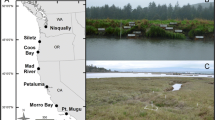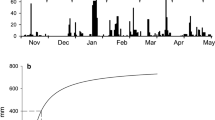Abstract
The hypothesis that rates of litter turnover in mangroves are controlled by local geophysical processes such as tides has been studied at sites with mostly small tides (<1 m) and minor crab consumption of leaf litter. Our study describes litter dynamics of three riverine mangrove sites (M1, M2, M3), inhabited by the mangrove crab Ucides occidentalis, located in a macrotidal (>3 m) river-dominated tropical estuary in Ecuador (2.5°S latitude). There were statistical effects of site and depth on soil salinities, but all mean salinities were <17 g kg−1. Daily rates of leaf litter fall were higher in the rainy compared to the dry season, although no seasonal effects were observed for other components of litter fall. Annual total litter fall rates were significantly different among sites at 10.64, 6.47, and 7.87 Mg ha−1 year−1 for M1, M2, and M3, respectively. There were significant site (M3 > M2 > M1) and season (rainy > dry) effects on leaf degradation, and both effects were related to differences in the initial nitrogen content of senescent leaves. Mean leaf litter standing crop among the sites ranged from 1.53 to 9.18 g m−2, but amounts were strongly seasonal with peak values during September in both years of our study (no significant year effect) at all three sites. Leaf turnover rates based on leaf fall estimates and litter standing crop were 10- to 20-fold higher than estimated from rates of leaf degradation, indicating the significant effect of leaf transport by tides and crabs. Field experiments demonstrated that the mangrove crab can remove daily additions of leaf material within 1 h at all three sites, except during August–October, when the crab is inactive on the forest floor. Even though there is seasonally elevated leaf accumulation on the forest floor during this time, leaf turnover rates are much higher than expected based on leaf degradation, demonstrating the importance of tidal export. This is the first description of how crabs influence litter dynamics in the New World tropics, and results are similar to higher rates of crab transport of leaf litter in the Old World tropics. Even in riverine mangroves with high geophysical energies, patterns of litter dynamics can be influenced by ecological processes such as crab transport.
Similar content being viewed by others
Author information
Authors and Affiliations
Additional information
Received: 17 June 1996 / Accepted: 13 January 1997
Rights and permissions
About this article
Cite this article
Twilley, R., Pozo, M., Garcia, V. et al. Litter dynamics in riverine mangrove forests in the Guayas River estuary, Ecuador. Oecologia 111, 109–122 (1997). https://doi.org/10.1007/s004420050214
Issue Date:
DOI: https://doi.org/10.1007/s004420050214




